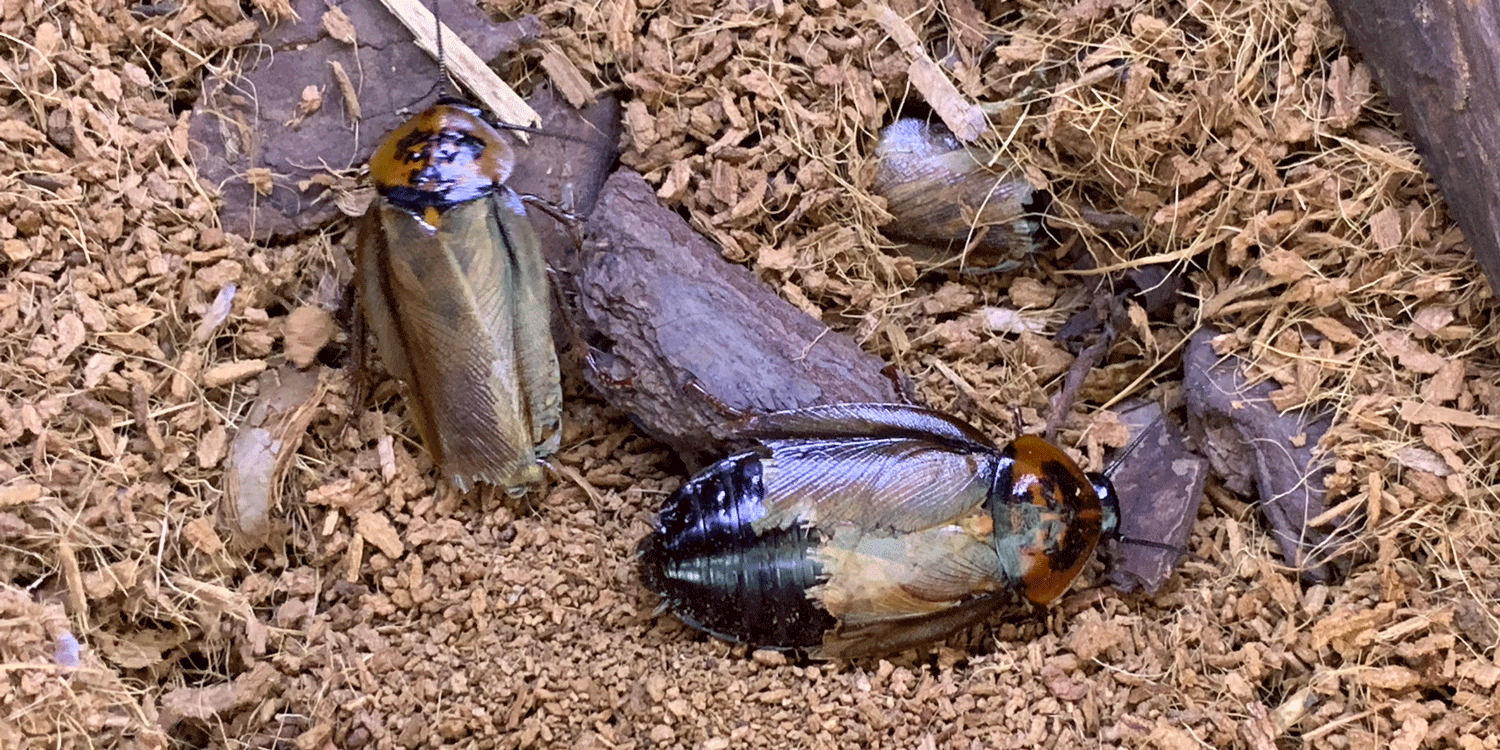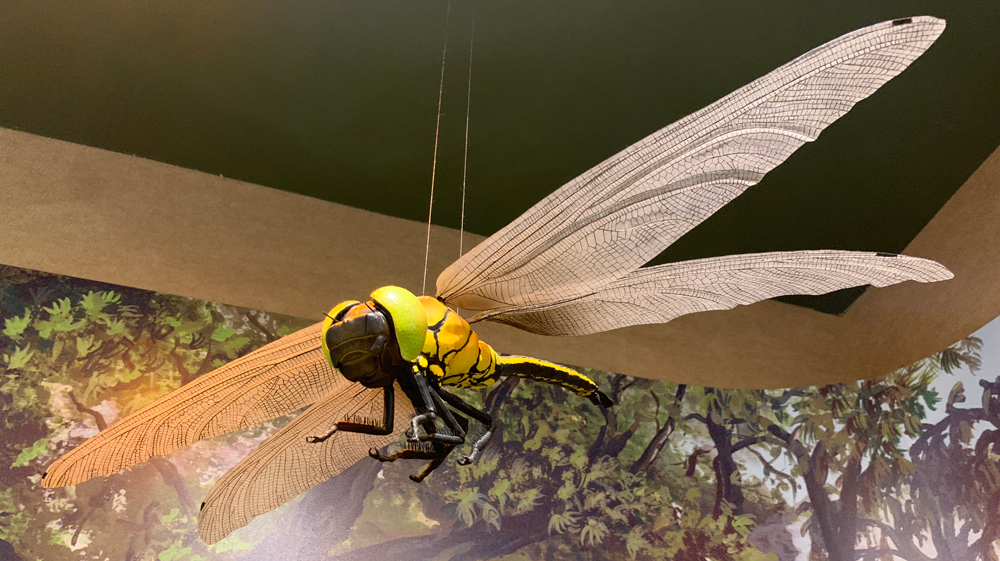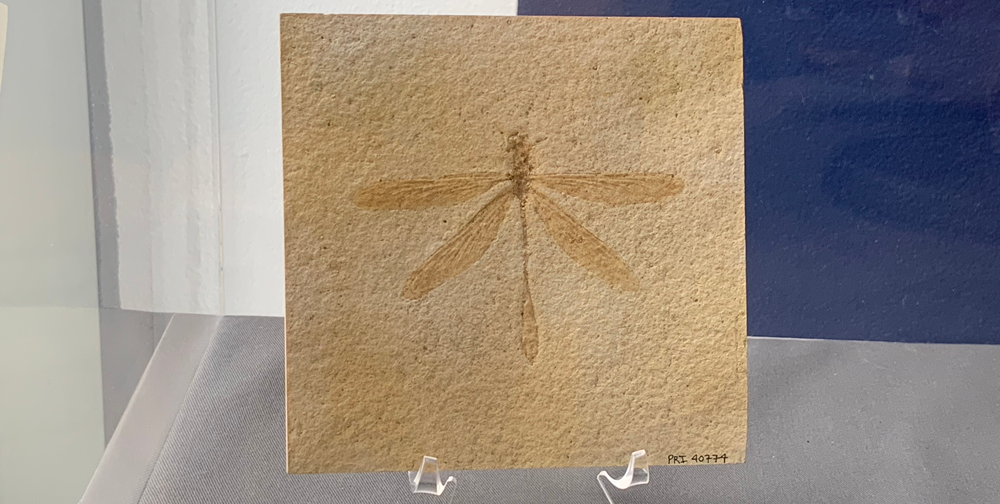Like other arthropods, insects have a jointed exoskeleton. They differ from other arthropods in having a 3-part body with 3 pairs of legs, compound eyes, and one pair of antennae. Insects have been around since the Devonian period (370 million years ago) and diversified in the Carboniferous, when plants created new habitats across the land. Many of the families that are common today, however, originated much later, in the Jurassic and Cretaceous periods, particularly along with the origin of flowering plants. These include, for example, butterflies, bees, and many kinds of beetles.

Fossils resembling modern cockroaches are known from rocks as old as the Carboniferous period (320 million years ago), when they dominated insect communities. The exact evolutionary relationships of these fossil insects with modern roaches remain unclear; they were probably distant “cousins” rather than ancestors.

Live specimens of orange head cockroach (Eublaberus posticus).
Fossil cockroach Etoblattina sp. from the Pennsylvanian of France (PRI 49722). Specimen is preserved as a carbonization. Specimen is on display at the Museum of the Earth, Ithaca, New York. Specimen is approximately 10 cm in length (estimate).
The fossil cockroach Promylacris ovalis from the Carboniferous of Illinois. Specimen is from the collections of the Field Museum of Natural History, Chicago, Illinois. Length of specimen (not directly measured) is approximately 5 cm.
Peppered cockroach (Archimandrita tessellata)
"Archimandrita tesselata (peppered roach) mating dance" by stijnghesquiere (YouTube).
Amazing Adaptation: Reproduction
The peppered cockroach (seen in the video above) is considered one of the largest species of cockroaches in the world. The females will choose the males with which they will mate. After mating, the female is pregnant for life and stores the fertilized eggs in her ootheca, where they are incubated for roughly 60 days. When the eggs are about to hatch, the female expels the ootheca so the nymphs can break free and feed on their first meal.
Orange head cockroach (Eublaberus posticus)
"Orange head cockroach (Eublaberus posticus) wrestling match" by Paul Huyong (YouTube).
Amazing Adaptation: Diet
The orange head cockroach (seen in the video above) lives only in caves occupied by bats, which creates an unusual challenge when trying to obtain food. Orange head cockroaches wait for a bat to fall to the floor and get stuck in the excrement of other bats. When the bat dies, they begin to feed.

Fossils of very large dragonfly-like creatures are found in rocks of Late Carboniferous age (about 325 million years old). These are history’s largest known insects, with some having wingspans of up to 28 inches. These giant insects (sometimes called griffenflies) were, however, extinct cousins, rather than ancestors, of today’s dragonflies, which first appeared in the Jurassic period (around 160 million years ago).
There are about 3,000 living species of dragonflies, the largest of which have wingspans of 6 inches.

Model of a large dragonfly from the Carboniferous period. On display at the Museum of the Earth, Ithaca, New York.

Artificial cast of a dragonfly fossil from the Jurassic of Germany.

Scorpions are predatory arachnids with eight legs, a pair of grasping appendages called pedipalps, and a narrow, stinger-tipped tail, often carried forward over the back. This basic body plan has remained almost unchanged for more than 400 million years. The oldest known fossil scorpions come from Early Silurian rocks (436 million years old). These early scorpions were amphibious, but all scorpions moved fully to the land within a few million years. There are 111 known fossil scorpion species, and - unusually for arachnids - they are more common in Paleozoic rocks older than 250 million years.
There are about 1750 species of modern scorpions, and they are found on all major landmasses except Antarctica.
Fossil scorpion (species unknown) from the Silurian of Indiana. Specimen is from the collections of the Yale Peabody Museum, New Haven, Connecticut. Length of specimen (not directly measured) is approximately 5 cm.
Asian forest scorpion (Heterometrus longimanus)
"Asian forest scorpion vs beetle" by Sauce Boss (YouTube).
Amazing Adaptation: Backup Plan
This scorpion (seen in the video above), found in the tropical forests of southeastern Asia, is nocturnal. It is active at night, and during the day hides in burrows or beneath logs and leaves. If it is caught out and about by a predator, the scorpion can protect itself with its strong pincers and the stinger at the tip of its long tail.
Contents: Introduction | Microbialites | Plants | Echinoderms | Fishes | Reptiles | Opossum | Brachiopods | Mollusks | Horseshoe Crabs | Insects & Arachnids



